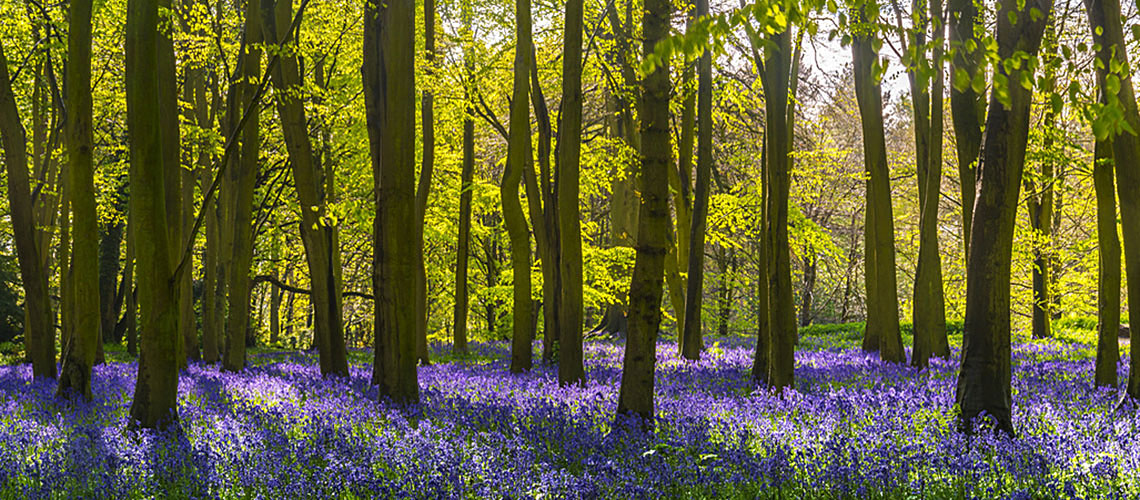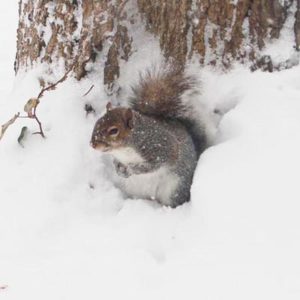Information for Participants in the 2019 Rachel Carson Intergenerational Sense of Wonder/Sense of the Wild Contest
NOTE: Contest requirements are unchanged from those of 2018
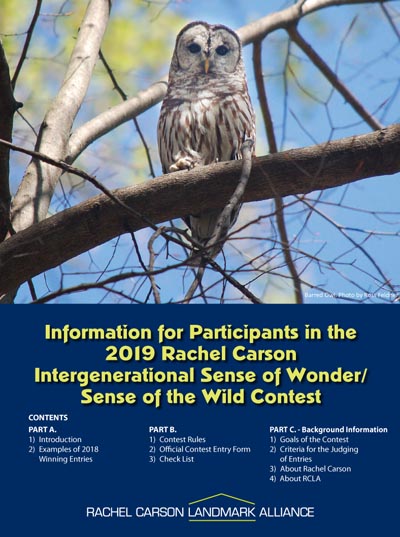 CONTENTS
CONTENTS
PART A.
1) Introduction
2) Examples of 2018 Winning Entries
PART B.
1) Contest Rules
2) Official Contest Entry Form
3) Check List
PART C. – Background Information
1) Goals of the Contest
2) Criteria for Judging Entries
3) About Rachel Carson
4) About RCLA
Part A. Introduction (A-1) and Examples of 2018 Winning Entries (A-2)
A-1 Introduction
Nature as a Source of Wonder
Wherever Nature endures, whether in a remote forest area, in a neighborhood park, in a backyard pollinator garden, in a babbling brook, on the banks of a mighty river, or at a place where ocean waves break on the rocky shore, it offers beauty, joy, excitement and healing for individuals open to experiencing its wonder. (Footnote 1)
Rachel Carson wrote, “There is something infinitely healing in…Nature.” (The Sense of Wonder)
Spending time in Nature, scientists tell us, makes people happier, healthier and even better able to evaluate information. (Footnote 2). Physicians increasingly are prescribing nature experiences to benefit patients of any age. (Sheikh, K., “Enjoy 2 Hours a Week in Nature, Doctors Say,” The NYT, 6-25-19) See Contest Goals (Part C) for further details.
Nature as a Source of Strength
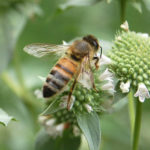 Scientists in 2005 identified the many ways in which nature is beneficial for human beings. These nature-based benefits are also called “ecosystem services”. (Footnote #3). These services depend on the everyday activities of many diverse plant and animal species thriving in different natural areas. These vital services generate clean air, clean water, healthy food and are the natural sources that help to keep our human societies strong. “In the Americas, nature provides some $24 trillion of non-monetized benefits to humans each year.” As stated by Emma Archer, “If you don’t take into account the value that nature provides, then ultimately human well-being will be compromised.” (Plumer, B., “Wildlife Facing Extinction Risk All Over Globe, U.N. Report Warns,” The NYT, 5-11-19).
Scientists in 2005 identified the many ways in which nature is beneficial for human beings. These nature-based benefits are also called “ecosystem services”. (Footnote #3). These services depend on the everyday activities of many diverse plant and animal species thriving in different natural areas. These vital services generate clean air, clean water, healthy food and are the natural sources that help to keep our human societies strong. “In the Americas, nature provides some $24 trillion of non-monetized benefits to humans each year.” As stated by Emma Archer, “If you don’t take into account the value that nature provides, then ultimately human well-being will be compromised.” (Plumer, B., “Wildlife Facing Extinction Risk All Over Globe, U.N. Report Warns,” The NYT, 5-11-19).
In May 2019 scientists reported that over a million species could soon become extinct due to various man-made hazards. (Footnote 4). Maintaining the biological diversity (the number and variety of wild species able to generate these ecosystem services) necessary to support life on our planet now and into the future requires a world-wide effort.
A recent U.N. Report calls for “transformative changes” to prevent the predicted loss of species. (Plumer, B., “Wildlife Facing Extinction Risk All Over Globe, U.N. Report Warns,” The NYT, 5-11-19). (Footnote 5)
Human beings everywhere need to start working with Nature to preserve biodiversity. What does this mean? In the words of Sandra M. Diaz, ecologist: “It’s no longer enough to focus just on environmental policy. We need to build biodiversity considerations into trade and infrastructure decisions, the way that health or human rights are built into every aspect of social and economic decision making.” (Plumer, B., “Wildlife Facing Extinction Risk All Over Globe, U.N. Report Warns,” The NYT 5-11-19).
In 2019 thousands of young people urgently demand that governments act to decrease man-made hazards to human health and nature from greenhouse gas emissions and other threats.
Awareness of why we need nature and why nature needs us can start at any age.
No matter what your age the Contest gives you an exceptional opportunity to leap into the wonder and strength of nature with an intergenerational team (Footnote 6). Connecting with another generation and preparing your Contest entry – could change your life.
Furthermore, we hear from teachers that teens very much enjoy taking part in our Contest. Winning Contest entries from 2018 came from the USA and abroad. (See A-2 for a sampling of 2018 winning Contest entries)
If this sounds interesting, please read our Contest Rules and Goals (Parts B&C) and plan to submit an entry.
Footnotes for Introduction
1. “The more clearly we can focus our attention on the wonders and realities of the universe about us, the less taste we shall have for destruction.” (Rachel Carson)
2. Nature experiences also help improve asthma, allergies, diabetes, cardiovascular disease and contribute to increasing life expectancy. (Sheikh, K., “Enjoy 2 Hours a Week in Nature, Doctors Say,” The NYT, 6-25-19)
3. What are “ecosystem services?” An ecosystem is a discrete unit consisting of living and non-living parts interacting to form a stable system. Ecosystem services are the benefits to humans that are generated by an ecosystem for example: an ecosystem can be a wetland such as a: bog, pond, marsh, swamp, or vernal pool. An ecosystem service by a wetland can include helping to buffer the impacts of floods and droughts, providing vital habitat for wildlife, and filtering pollution from our waters (W.R. Irvin, “Protecting the world’s species,” Letter to Editor, The Wash. Post, 5-11-19)
4. “When we destroy nature, we undermine our quality of life.” (Plumer, B., “Species Are Dying. Who Is Listening?” The NYT, 5-11-19) Earth’s natural ecosystems are at greater risk.
- By releasing greenhouse gas emissions we humans contribute to Global Climate Change and bring about higher air and water temperatures worldwide that result in higher rates of disease for ourselves and the potential extinction of plant and animal species.
- By continuing to introduce intensive farming, aggressive logging, and overfishing practices into natural areas, we decrease the number of wild species required for maintaining a level of biodiversity, to assure the survival of ecosystems and production of critical ecosystem services.
- Hazardous levels of pesticides and nutrients from agriculture, and hazardous waste from industries that contaminate water and land reduce habitat that wildlife need for survival and that humans need for a healthy lifestyle.
5. Transformative changes are needed by governments to reduce the adverse effects of man-made hazards on human health and nature.
- Set a deadline to eliminate greenhouse gas emissions worldwide
- Protect wild habitats such as forests and wetlands from degradation and destruction to the highest degree possible
- Enforce environmental laws such as those that reduce illegal logging and overfishing, as well as those that govern the disposal of hazardous waste
- Protect endangered and threatened species
- Promote a shift to sustainable farming practices
6. Contest entries are required to be from an intergenerational team of 2 or more individuals from different generations. Why? Team members who are older individuals (parents, grandparents, teachers) provide a “sense of wonder” to encourage, educate and enrich the experiences in nature of young team members.
The enthusiasm for nature in the young can enable older participants to appreciate and reconnect with familiar experiences by seeing them through fresh, eager, “sense of wonder” eyes.
A-2 Examples of 2018 Winning Entries
Here are 4 winning entries from the US and abroad written by teams led by Vedika, Camille, Seonghyun and Sean. Click here to read them.
Part B. Contest Rules (B-1), Entry Form (B-2) and Check List (B-3)
B-1 Contest Rules
a. Requirements (Contest requirements are unchanged from those of 2018):
1 Team:
- You Are Required To Have a Team of 2 or More
People.
Entries must be submitted by a team, consisting of at least two people, representing different generations (for example, a teacher and a student). They can be relatives or not.
- The Team Must Be Intergenerational.
The team must have members from two, or more, different generations.
- All Team Members Must Read the “Background Information” Section, Part C.
- Your Team Must Choose 1 of these 2 Themes
(look under Additional Information for definitions):
– “Sense of Wonder” or
– “Sense of Wonder/Sense of The Wild”
3 Category:
- Your Team Must Decide On Its Writing Category:
– “Poem” or
– “Essay”
- An Original Photograph Taken By Your Team May Be Added To Either Category.
- Contest Themes and Categories:
• Sense of Wonder Theme, Poem Category
• Sense of Wonder Theme, Essay Category
• Sense of Wonder Theme, Poem with Photograph Category
• Sense of Wonder Theme, Essay with Photograph Category
• Sense of Wonder/Sense of the Wild Theme, Poem Category
• Sense of Wonder/Sense of the Wild Theme, Essay Category
• Sense of Wonder/Sense of the Wild Theme, Poem with Photograph Category
• Sense of Wonder/Sense of the Wild Theme, Essay with Photograph Category
4 Entry “Form:”
- Your Entry Must Include a Fully Completed, “Official Entry Form for the 2019 Rachel Carson Intergenerational Sense of Wonder/Sense of The Wild Contest.”
- Directions for downloading, filling in, and submitting this form are included below, and on the Entry Form itself.
b. Additional Information:
1 Your Team:
- Names and ages of all team members must be listed on the Official 2019 Entry Form.
- A team member can come from within the U.S. or outside the U.S.
- An individual may be a member of more than one team.
- A teacher may be a team member.
- The team will retain rights to use the submission for other purposes.
2 Defining the Contest’s Themes:
• The Sense of Wonder Theme:
This theme appears in Rachel Carson’s book, The Sense of Wonder (1965). It describes having an appreciation for a positive, outdoor, nature-centered experience.
- The book focuses on an intergenerational sharing of these experiences.
- Those interested in this contest are strongly encouraged to read The Sense of Wonder. It is available in paperback.
- The Contest encourages teams to share “Sense of Wonder” experiences and to describe them in words (either through poetry or an essay), with the option of an accompanying photograph.
3 The Sense of Wonder/Sense of the Wild Theme:
This theme combines a Sense of Wonder experience with awareness of the benefits provided to us by wild plants and animals living in their natural habitats. Details about the beneficial work of insects are found in Silent Spring’s 17th Chapter “The Other Road” and in the 15th Chapter “Nature Fights Back.” As Caroline Fraser noted: “The species we…share space with are indispensable…Without them the attainments we take for granted—agriculture, medicine, our tenuous security on this planet—fall away.” (p. 352, Rewilding the World, Henry Holt Co., 2009) Ecosystem services from around the world are described in The Work of Nature: How the Diversity of Life Sustains Us (by Yvonne Baskin, pp. 224, Island Press, 1997). In Part C-1.b under “Contest Goals” there are examples of nature’s vital resources.
4 Length and Other Specifications — By Contest Categories:
- Poem: The maximum length for a poem is 500 Words (or 2 pages)
- Essay: The maximum essay length is 500 Words (approximately 2 pages)
- Poem with Photograph: The maximum length for a poem is 500 Words (or 2 pages). Original photographs only; the photographer must be identified by name. Send your photograph electronically as a .jpg file, minimum 300 ppi, size: 100 %. Limit: one photograph per team.
- Essay with Photograph: The maximum essay length is 500 Words (approximately 2 pages). Original photographs only; the photographer must be identified by name. Send your photograph electronically as a .jpg file, minimum 300 ppi, size: 100 %. Limit: one photograph per team.
5 What Winners Receive:
- Winners will receive a certificate from RCLA. Their first names and ages (optional) along with the title of their winning entry will be posted on the RCLA website. A portion or all of the winning entry may be posted on the RCLA website.
B-2 Official Contest Entry Form:
a. Downloading the Form
- Click here to download the Official Entry Form for the Contest.
- “Save as” the completed form as a PDF, and give it a new name that includes the last name of the first team member.
- This form must be filled out fully and submitted your written entry (and photo, if any).
b. Submitting the Completed Form
- Send by email to:
rachelcarsonlandmark@verizon.net
- Send by U.S. mail to:
Rachel Carson Landmark Alliance
11701 Berwick Road
Silver Spring MD 20904
C. Deadline for Entering the Contest:
- The Deadline for receiving entries at our office is
November 16, 2019 at 5:00 p.m., EST.
B-3 Check List for 2019 Contest Entries:
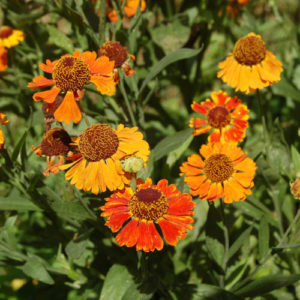
![]() Pick the members of your Intergenerational Team — which must contain individuals from 2 generations. Confirm that your team is intergenerational. It must contain individuals from 2 generations.
Pick the members of your Intergenerational Team — which must contain individuals from 2 generations. Confirm that your team is intergenerational. It must contain individuals from 2 generations.
![]() Indicate that all team members have read Part C “Background Information.”
Indicate that all team members have read Part C “Background Information.”
![]() Choose with your team, a Theme, either:
Choose with your team, a Theme, either:
– “Sense of Wonder” or
– “Sense of Wonder/Sense of the Wild”
![]() Choose with your team, a Category: either a poem or an essay. You may also decide to add an original photograph. The 4 categories are.
Choose with your team, a Category: either a poem or an essay. You may also decide to add an original photograph. The 4 categories are.
• “Poem”
• “Essay”
• “Poem with Photograph”
• “Essay with Photograph”
![]() With your team identify a subject area or topic for your entry.
With your team identify a subject area or topic for your entry.
![]() Create your entry using the guidelines provided.
Create your entry using the guidelines provided.
![]() Download 2019 Official Contest Entry Form. IMPORTANT: After filling out the “fillable” PDF “Save As” new file giving a name that includes the name of the first team member.
Download 2019 Official Contest Entry Form. IMPORTANT: After filling out the “fillable” PDF “Save As” new file giving a name that includes the name of the first team member.
![]() After your written entry is complete and has a title, check that it contains a fully filled out, official “2019 Rachel Carson Intergenerational Sense of Wonder/Sense of the Wild Contest” entry form, save it and print it. If you plan to send it by email check that its name includes the last name of the first team member. Retain a printed copy, and check to make sure that what you have printed is not just a blank entry form (which can occur if you failed to save your entry as a new document).
After your written entry is complete and has a title, check that it contains a fully filled out, official “2019 Rachel Carson Intergenerational Sense of Wonder/Sense of the Wild Contest” entry form, save it and print it. If you plan to send it by email check that its name includes the last name of the first team member. Retain a printed copy, and check to make sure that what you have printed is not just a blank entry form (which can occur if you failed to save your entry as a new document).
![]() After you have satisfactorily completed the above step, the written portion of your entry is ready for submission.
After you have satisfactorily completed the above step, the written portion of your entry is ready for submission.
![]() If your entry includes a photograph, verify that it is an original photograph taken by a member of your team and that the photographer is identified on your entry form. If you send it by email, be sure to attach the photograph as a .jpg file, minimum 300 ppi, size 100%.
If your entry includes a photograph, verify that it is an original photograph taken by a member of your team and that the photographer is identified on your entry form. If you send it by email, be sure to attach the photograph as a .jpg file, minimum 300 ppi, size 100%.
![]() Now, you may submit your Contest Entry.
Now, you may submit your Contest Entry.
![]() Contest Deadline: November 16, 2019, 5:00 p.m. EST.
Contest Deadline: November 16, 2019, 5:00 p.m. EST.
Contact RCLA With Any Questions
Phone: 301-593-4900
Email: rachelcarsonlandmark@verizon.net
Part C. Background Information Including – Contest Goals (C-1), Judging Criteria (C-2), About Rachel Carson (C-3), About RCLA (C-4)
C-1 Our Overall Contest Goal Is to Help Individuals and Society Benefit from Rachel Carson’s Legacy, using these concepts:
C-1.a) A Sense of Wonder,
C-1.b) A Sense of Wonder/Sense of the Wild,
C-1.c) Carson-Derived Writing Elements.
C-1.a A Sense of Wonder Theme
Contest entries with this theme involve an intergenerational team (2 or more individuals from different generations) undergoing positive, outdoor, nature-centered experiences. Team members then call on these events to create a poem or essay incorporating their personal responses to nature.
Why Outdoors? Rachel Carson’s book, The Sense of Wonder describes how time spent in nature contributes to the health and well-being of individuals. More recently, researchers have confirmed her observations by measuring the beneficial health effects of nature experiences. (Bratman, G., Daily, G., et al, “The Benefits of Nature Experience: Improved Affect and Cognition,” Landscape and Urban Planning, June 2015) Teen depression can be reduced when young people spend time in green and growing natural settings. (Bezold, C., et al, “The Association between Natural Environments and Depressive Symptoms in Adolescents Living in the U.S.,” J. of Adolescent Health, 2017) Behavioral scientists report that nature experiences can lead us “…to act more generously and ethically [and to] think more critically when encountering persuasive stimuli, like arguments or advertisements.” (Abrahamson, J., “The Science of Awe,” Sierra Magazine, Nov/Dec 2014)
Encouraging people of all ages to spend time outdoors is an important goal for our Contest.
C-1.b Sense of Wonder/Sense of the Wild Theme
Choosing this theme involves incorporating Carson’s aesthetic appreciation of nature along with a focus on one or more examples of how we humans depend on nature for essential benefits. For instance, regarding microbes Carson wrote that they: “…include not only disease organisms but those that destroy waste matter, make soils fertile, and enter into countless biological processes like fermentation and nitrification.” (Silent Spring, p. 289)
Examples of services performed by wild species — routinely in the functioning ecosystems where they live:
- Dragonflies and other beneficial insects helping to control mosquitoes and other pests
- Oak Trees performing many functions including hosting up to 500 species of caterpillars that help to provide essential food for baby birds
- Oysters: Helping to clean natural bodies of water
- Wild bees, wasps, butterflies and birds: pollinating crops and wild vegetation
Examples of services performed by functioning ecosystems composed of diverse species:
- The Amazon rain forest absorbing immense quantities of carbon dioxide and helping to slow the pace of global warming
- Soil and Wetlands purifying drinking water
- Coral reef organisms sustaining fisheries
- Mangrove forests helping to protect coastlines from flooding risks (Plumer, B., “Wildlife Facing Extinction Risk All Over Globe,” The NYT, 5-7-19)
- Growing trees absorbing and storing carbon dioxide
- Plants supporting animal life, “Water, soil and the earth’s green mantle of plants make up the world that supports the animal life of the earth.” (Silent Spring, p. 63)
Why Awareness of Wildlife as a Source of Wonder and Worth Is Important Today
Increasingly, threats to wild species are traced to human activity. Across our planet species contributing to our well being (such as coral reef organisms creating fish habitats and wild pollinators increasing crop yields) are being lost at an alarming rate — unprecedented in human history. Scientists predict that this decrease in biodiversity, if it continues, foretells serious problems for humans. The essential services of wild species in their ecological habitats contribute to our food security, clean air, clean water and livable climate. (Plumer, B., “Wildlife Facing Extinction Risk All Over Globe,” The NYT, 5-7-19) All life on the planet is in danger from loss of biodiversity.
A U.N. Report estimated that “in the Americas, nature provides some $24 trillion of non-monetized benefits to humans each year.” (Plumer, B., “Wildlife Facing Extinction Risk All Over Globe,” The NYT, 5-7-19) These services are not given actual monetary value in most national economies. As a result, functioning ecosystems are undervalued for the essential services they provide to humans.
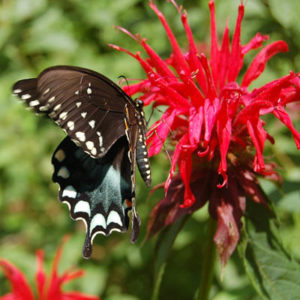 People everywhere need to become aware of the importance of ecosystem services to all life on the planet so they can help to protect threatened wild plants and animals – the sources of these services. Governments need to acknowledge the value of these services (including the importance of preserving biodiversity) in their economic projections. Citizens calling for such governmental action can help lead society toward a sustainable future.1
People everywhere need to become aware of the importance of ecosystem services to all life on the planet so they can help to protect threatened wild plants and animals – the sources of these services. Governments need to acknowledge the value of these services (including the importance of preserving biodiversity) in their economic projections. Citizens calling for such governmental action can help lead society toward a sustainable future.1
Participants who become aware of the value to society of biodiversity and of the need for working with, not against, nature help to fulfill a desired RCLA Contest goal.
Below is one approach for dealing with the Sense of Wonder/Sense of the Wild (Source of Wonder and Worth) theme.
Team members choose a favorite aspect of nature (a bird, a tree, or a river and describe how it makes you feel (sense of wonder theme), then describe (for a mammal, bird, insect, tree) the species it represents and how that particular species or in the case of a river (the particular ecosystem) contributes services that enhance your lives. This (sense of the wild theme) may be based on information researched from the scientific literature. Further, you may want to describe how you could help assure protection of your source of wonder and worth.
Suggested Reading:
The Work of Nature: How the Diversity of Life Sustains Us (by Yvonne Baskin, pp. 224, Island Press, 1997).
FOOTNOTE
1Governments urgently need to help reduce the predicted loss of over one million species and the other dangerous outcomes linked to human-generated activities that threaten our planet’s ecosystems and our own societies. These remedial actions include world-wide reductions of greenhouse gas emissions (carbon dioxide, methane, etc.) to lower the present global climate change emergency. Governments need to enforce environmental laws, and reduce illegal logging and fishing. There is a need for reducing the flow of contaminants (heavy metals, solvents, pesticides, antibiotics, nutrients, plastic waste and other human-generated hazardous material) into the environment. Finally, governments need to fund nature-based programs on ways to promote biodiversity in all of the following: agriculture, fisheries, tourism, forestry, infrastructure, health, manufacturing and consumer education. (J. Hance “Biodiversity is the infrastructure that supports all life,” The Guardian, June 28, 2018). Without pressure from concerned citizens, governments cannot be counted on to take the above steps voluntarily. Actions to preserve biodiversity can give nature a better chance for resilience and the ability to adapt to the climate change emergency we face today and into the future.
C-1.c.* Three Important Elements of Rachel Carson’s Writing
Expressiveness: Conveying in writing the positive, immediate effects that a nature-based encounter can have on our senses (hearing, sight, smell and touch) is an important part of sharing the experience with others and understanding our own needs. It helps develop expressiveness.
Thoughtfulness: Reflecting on how a nature encounter has impacted our perceptions about the environment calls for engaging in thoughtfulness.
Accuracy: Addressing the work of wildlife (aka ecosystem services), requires obtaining supporting evidence from reliable scientific sources that adhere to accuracy.
Goal: Expressiveness, thoughtfulness and accuracy in writing contribute to an individual’s communication skills — and help to reach a Contest goal.
C-1.c** Sampling Rachel Carson’s Work
The words of this great American author can provide hours of reading pleasure, and for those in search of a writing mentor, examples of a powerful, enduring, masterful literary style.
Selected references from Rachel Carson’s work are found below following Part (C-3) “About Rachel Carson”.
C-2 Criteria for Judging Entries
Primary Criteria: Entries are evaluated on content, and how well they capture a sense of wonder or a sense of wonder/sense of the wild experience. They are also evaluated on the writing itself for expressiveness and thoughtfulness (reflecting the sense of wonder theme) as well as for accuracy (especially in the case of the sense of the wild theme). These elements found in Rachel Carson’s writing are discussed in the Contest Goal Section C-1.c.* Three Important Elements of Rachel Carson’s Writing.
The judges also consider:
- How the intergenerational team planned and carried out the project
- How the creative project brought the team in touch with the natural world
Poems and even essays can be wonderful vehicles for presenting Rachel Carson’s “sense of wonder,” as a kind of discovery process. The most exciting entries are those that take the reader along on a journey evoking the sounds, sights, smells, tastes and feelings encountered on the way, rather than relying on direct statements to convey “wonder.” Imagery is the engine that can drive this kind of writing and can make reading a winning poem (or a winning essay) a memorable experience. The most successful teams tend to be those who venture out together.
C-3 About Rachel Carson
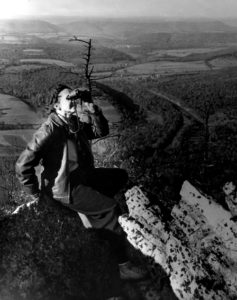 Rachel Carson (1907–1964) is considered one of America’s most influential authors. She wrote three books about sea life, Under The Sea Wind (1941), The Sea Around Us (1951), The Edge of the Sea (1955), all attracted wide readership and made the best seller list. However, it was her fourth book, the splendid, groundbreaking Silent Spring (1962) where she had her most profound impact: on the reading public, on public policy, and on the academic world. In this book, Rachel Carson documented threats to the environment and to human health from exposure to chemical pesticides, which until then had been viewed by many in the public as harmless technological miracles. Silent Spring altered the public’s perspective and attitude about our enviroment. Rachel Carson, through this book, is generally acknowledged as having launched the modern environmental era as well as the interest in ecology. Silent Spring was translated into a number of languages and had a major impact in many countries. For this work, Carson received many accolades and awards: from conservation groups, women’s groups, and writer’s groups. Carson’s last book, The Sense of Wonder (1965) discussed the intergenerational communication of a special delight in the beauty of nature.
Rachel Carson (1907–1964) is considered one of America’s most influential authors. She wrote three books about sea life, Under The Sea Wind (1941), The Sea Around Us (1951), The Edge of the Sea (1955), all attracted wide readership and made the best seller list. However, it was her fourth book, the splendid, groundbreaking Silent Spring (1962) where she had her most profound impact: on the reading public, on public policy, and on the academic world. In this book, Rachel Carson documented threats to the environment and to human health from exposure to chemical pesticides, which until then had been viewed by many in the public as harmless technological miracles. Silent Spring altered the public’s perspective and attitude about our enviroment. Rachel Carson, through this book, is generally acknowledged as having launched the modern environmental era as well as the interest in ecology. Silent Spring was translated into a number of languages and had a major impact in many countries. For this work, Carson received many accolades and awards: from conservation groups, women’s groups, and writer’s groups. Carson’s last book, The Sense of Wonder (1965) discussed the intergenerational communication of a special delight in the beauty of nature.
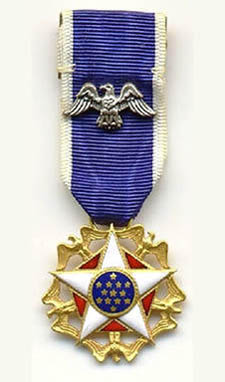 The decade following Silent Spring’s publication saw the founding of the US Environmental Protection Agency (1970) and the passage of a number of key federal environmental protection acts, including the Clean Air Act, The Clean Water Act. In 1972, the banning of all but a few uses of the insecticide DDT occurred in the USA. On June 9, 1980 (sixteen years after her death) Rachel Carson was awarded the Presidential Medal of Freedom by President Jimmy Carter. The citation reads:
The decade following Silent Spring’s publication saw the founding of the US Environmental Protection Agency (1970) and the passage of a number of key federal environmental protection acts, including the Clean Air Act, The Clean Water Act. In 1972, the banning of all but a few uses of the insecticide DDT occurred in the USA. On June 9, 1980 (sixteen years after her death) Rachel Carson was awarded the Presidential Medal of Freedom by President Jimmy Carter. The citation reads:
“Never silent herself in the face of destructive trends, Rachel Carson fed a spring of awareness across America and beyond. A biologist with a gentle, clear voice, she welcomed her audiences to her love of the sea, while with an equally clear determined voice she warned Americans of the dangers human beings themselves pose for their own environment. Always concerned, always eloquent, she created a tide of environmental consciousness that has not ebbed.”
Selected References from Rachel Carson’s Work
From: The Sense of Wonder (1965 edition)
p. 68 “Take time to listen and talk about the voices of the earth and what they mean”
p. 88 “Those who contemplate the beauty of the earth find reserves of strength that will endure as long as life lasts… There is something infinitely healing in the repeated refrains of nature…”
Last page “The lasting pleasures of contact with the natural world… are available to anyone who will place himself under the influence of earth, sea and sky and their amazing life.”
From: Silent Spring
p. 46 “Water must be thought of in terms of the chains of life it supports… in the endless cyclic transfer of materials from life to life.”
p. 63 “Water, soil and the earth’s green mantle of plants… that harness the sun’s energy and manufacture the basic foodstuffs he [man] depends on for life.”
p. 111 “All the treetop feeders, the birds that glean their insect food from the leaves…, whose migrating hordes flow through the trees in spring in a multicolored tide of life.”
p. 251 “All these small creatures are working – working in sun and rain, during the hours of darkness, even when winter’s grip has damped down the fires of life to mere embers. Then this vital force is merely smoldering, awaiting the time to flare again into activity when spring awakens the insect world.”
From: The Edge of the Sea
p. 5 The little crab alone with the sea became a symbol that stood for life itself – for the delicate, destructible, yet incredibly vital force that somehow holds its place amid the harsh realities of the inorganic world.”
p. 140 “Walking back across the flats of that Georgia beach, I was always aware that I was treading on the thin rooftops of an underground city… the inhabitants remained hidden, dwelling silently in their dark, incomprehensible world.”
The selected excerpts from Rachel Carson’s published works are here to encourage reading the text in its original full form.
C-4 About Rachel Carson Landmark Alliance
Rachel Carson Landmark Alliance (RCLA) is a 501(c)(3) non-profit organization dedicated to developing educational information and intergenerational initiatives for public participation that reflect Rachel Carson’s ecological legacy and her courageous life in conjunction with the National Historic Landmark House where she wrote Silent Spring. This site with its library inside and wildlife habitat outside is suffused with Ms. Carson’s deep reverence for scientific truth and her dedication to preserving a natural, sustainable environment wherever possible.
RACHEL CARSON LANDMARK ALLIANCE
11701 BERWICK ROAD
SILVER SPRING MD 20904-2767
(301) 593-4900
rachelcarsonlandmark@verizon.net
www.rachelcarsonlandmarkalliance.org

